Unlock the Secrets of Social Media: A Beginner's Guide to Social Listening for Business Growth
In today's interconnected world, social media has become an integral part of how we communicate and share information. Billions of conversations take place on various social platforms every day, covering a wide range of topics and issues. As a business, it is highly likely that many of these discussions will be relevant to you and your organisation. From mentions of your brand, to conversations about your competitors, industry trends, and the problems that your business can solve, social media can provide a wealth of valuable insights.
But how do you make sense of all this information and use it to your advantage? This is where social media listening comes in. Social media listening is the process of monitoring your brand's social media channels for any customer feedback and direct mentions of your brand or discussions regarding specific keywords, topics, competitors, or industries. By analysing this data, businesses can gain valuable insights that can help them better understand their target audience, evaluate their online presence, and improve their overall marketing strategies.
In this guide, we aim to empower you with all the knowledge you need to start using social listening to your advantage and grow your business. From understanding the basics of social media listening, to learning about its key features and benefits, we will explore everything you need to know to make the most of this powerful tool. So, stick around and discover the what, why, and how of this amazing process!
{{toc}}
What is Social Media Listening?
Social listening is the practice of monitoring your brand's social media channels for any customer feedback and direct mentions of your brand or discussions related to specific keywords, topics, competitors, or industries.
This information is then analysed to gain valuable insights and take action on opportunities that arise. Whether it be a brand, an industry, or anything else, social media listening can provide valuable insights to help businesses understand consumer mindsets, evaluate their online presence, and improve their position in the market.
The insights garnered from social listening can then be used to inform product development, business operations, marketing, advertising and other areas of the business.
Social Listening vs. Social Monitoring
What is the difference between social media listening and monitoring?
While these two terms may seem similar, they are in fact quite different. Social monitoring is the process of collecting publicly available mentions across social media platforms. This typically includes tracking social media metrics to measure the performance of specific campaigns.
Key purposes of social monitoring include:
- Measuring campaigns
- Hashtag tracking
- Monitoring brand reputation
- Preventing PR crises
For example, a toy and board game company may monitor Twitter for mentions of its new product, a self-assembling puzzle. Once detected, the business may respond to the mention but it is not obligated to do so. The main focus of monitoring is gathering information, without necessarily having a specific strategy attached. The business can see all the different ways its self-assembling puzzle comes up in online conversations.
Social listening, on the other hand, has a broader scope. It is the process of understanding the context and sentiment of online conversations in order to gain deeper insights. This allows businesses to perform sentiment analysis around their brand, with the goal of improving their marketing strategy or product development.
Key purposes of social media listening include:
- Conducting sentiment analysis
- Measuring estimated reach
- Measuring share of voice
- Discovering the context of a discussion
For example, the same toy and board game company monitors social media for mentions of its new self-assembling puzzle and aggregates the data to perform a sentiment analysis of what people are saying. The company uses the information collected to develop a broader marketing strategy. By using sentiment analysis, it can determine the following:
- Whether people like the self-assembling puzzle
- What they like about it
- Whether people recommend it to their friends
- How long the puzzle should be on sale
- New ideas for its next featured product
In summary, social media listening can help businesses better understand their audience and their needs, while social monitoring can assist in tracking the success of marketing efforts.
How does social listening work?
Social media listening is a process that aims to monitor relevant conversations on social media platforms, comprehend the underlying sentiment and respond with a marketing strategy that positively influences sentiment. The social listening process is made up of three main stages:
- Monitoring: This includes monitoring various social media channels for mentions of brand names, topics, competitors, keywords, and products in social conversations. A business can carry out this type of brand monitoring manually by checking social media sites daily or more frequently, or it can use a tool to automate the process.
- Analysis: This is the stage that sets social listening apart from monitoring. Companies analyse the information gathered during monitoring to identify what customers like and dislike about a product or service, and look for patterns and trends. Various customer sentiment analysis tools are available that use automated software to provide companies with insight into the emotions behind the text customers write or say.
- Response: Companies may then choose to respond. This may be a small response, such as communicating with a customer online, or a bigger one, such as repositioning the entire brand strategy.
Companies can also use the information collected from social listening for other purposes, including:
- Identifying potential customers and unhappy existing ones
- Gauging the quality of customer experience (CX)
- Collecting information for return-on-investment monitoring or A/B testing different versions of a campaign to compare performance.
Benefits of social listening
- Understand your audience:
Social media listening enables you to comprehend what your audience wants from your brand. For example, an existing customer might tweet about how much they love your product or you might come across a conversation where people are looking for solutions that your product or service could provide. In both cases, you can utilise this valuable feedback to improve your offering and make your customers happier.
@dhlexpressuk actively listens and responds to users who have questions or concerns.
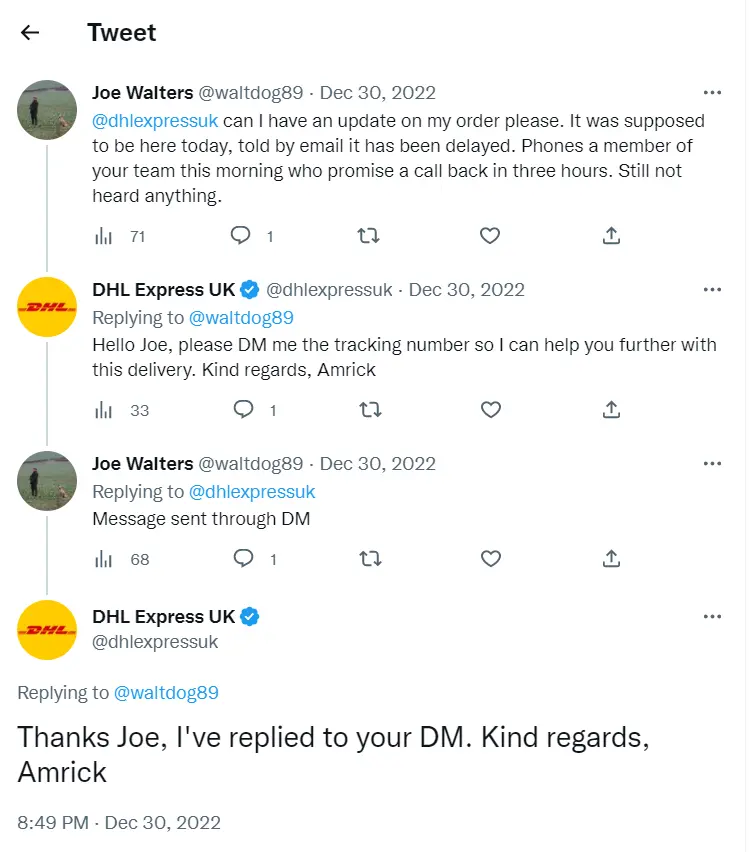
- Business and product intelligence:
Monitoring conversations within the industry also reveals a wealth of insight into what's working - and what's not - for existing and potential customers. This information is a goldmine for your customer service, product development, and marketing teams. You can tweak an existing product or add a feature to resolve problems people are talking about or use the information to develop new product ideas. - Crisis management:
Social listening allows you to track sentiment in real-time, so you can know immediately if there's a significant change in how much people are talking about you or the mood behind what they say. It's like an early warning system that alerts you to positive and negative changes in how your brand is perceived online. - Customer relationships and acquisition:
People generally appreciate it when you offer to help solve their problems. But strangers on the Internet most certainly do not appreciate it when brands jump into their social conversations with a hard sell. While social media listening can help you uncover questions and conversations about your industry on social platforms, it should not be seen as an opportunity to jump in and try to sell right away. Instead, view the conversation you join through social listening as an opportunity to develop relationships with potential customers in your industry who you can nurture into relationships for social selling. - Collaboration opportunities:
Monitoring social conversations about your industry will give you a sense of who the important creators and thought leaders are in your space. These are important people to connect with as they can have a huge influence on how people feel about you. Remember, this is a two-way street. Supporting others in your industry makes it more likely they will support you in return. Instead of trying to barge into an existing community, connect through collaborations with people who already hold a meaningful place in the conversations you want to join. - Competitor and industry trends:
Social media listening can also be used to gain insight into what people are saying about competitors and the industry as a whole. This can help businesses to understand where they fit in the marketplace, and to stay ahead of the competition. - Uncovering market trends:
Social media is constantly evolving, and tracking relevant keywords and hashtags can help businesses to stay on top of the latest trends in their industry. This can help businesses to ensure their content strategy is current, and to identify new opportunities. - Improving campaign targeting:
Social media listening can also be used to improve the targeting of social media advertising campaigns. By understanding the needs and preferences of their audience, businesses can create personalised campaigns that resonate with customers and increase their effectiveness.
How to do social listening? 8 steps
Social listening is a powerful tool for businesses looking to stay ahead of the game and gain valuable insights into their audience. However, it can be a daunting task to set up and execute a social listening strategy. In this guide, we will take you through 8 essential steps to create a successful social listening plan.
Step 1: Define Your Goals
Before you begin, it is important to take some time to clearly define your goals. What do you hope to achieve through social media listening? Are you looking to gain a deeper understanding of your customers, stay ahead of industry trends, monitor your competition, figure out what kind of content to share based on trends and data, identify your key social media audiences to better inform your targeting strategy, or all of these and more? Having a clear idea of what you want to achieve will help you stay focused and make the most of your social listening efforts.
What’s your goal?
- Run a deep analysis on your brand to understand what customers and prospects think.
- Monitor your industry or niche to keep a pulse on what’s new and what would make good content.
- Keep an eye on your competitors’ products, audiences and marketing tactics.
- Figure out what kind of content to share based on trends and data.
- Identify your key social media audiences to better inform your targeting strategy.
- All of these and more.
Step 2: Pick a Social Media Listening Tool
Manually researching social media channels to identify valuable mentions may not be the most effective approach. Not only is it time-consuming, but there is also a high chance of missing important posts. Using a social listening tool can automate this process, helping you to identify the most popular and important mentions.
Therefore, it is important to choose the right tool that will aid you in achieving your goals. Many tools offer free trials, so it is worth taking advantage of these to test out different options before making a decision.
When selecting a tool, consider the following factors:
- The number of sources that the tool can monitor
- The features that will support your goals
- The cost-effectiveness of the pricing
- Reviews posted on tools review websites (such as G2 and Capterra)
- The availability of customer support
Step 3: Infuse your plan with strategies
Think of your goals as the destination, and your strategy as the route to get there. Would you set off on a journey without a map or GPS?
Social media listening holds limitless potential, so it can be easy to get lost or overwhelmed by the possibilities as you work towards your goals.
To ensure you reach your destination, it is important to have a guide to help you through the strategies and tactical steps required to make sense of the data you find.
Step 4: Choose the keywords to monitor
Social media listening tools can track mentions of brand names, hashtags, specific keywords, and phrases. It is crucial to define what you want to monitor by selecting keywords that align with your goals.
Consider the following:
- The name of your brand, product, or service
- Your company hashtag
- Your campaign-specific hashtag
- The name of your CEO or any other prominent employee
- Keywords related to your business niche
Step 5: Choose your data sources
When constructing your social media listening strategy, decide which networks to draw data from. While it may be tempting to gather data from every possible source, this can lead to being overwhelmed by unnecessary data.
However, it is recommended to draw data from Twitter, even if your business doesn't have a presence on the network. This is because Twitter is renowned for its frequent social media messages, with millions of users sharing their feedback, making it likely that there will be conversations surrounding your organisation.
Step 6: Create your Topics and Themes
The exciting stage is here, where you get to create your listening topics. To start finding and gathering relevant data, you'll need to create specific queries. Consider the following:
- Keywords or phrases
- Hashtags
- Cashtags
- Mentions of a user
- Mentions from a user
- Mentions to a user.
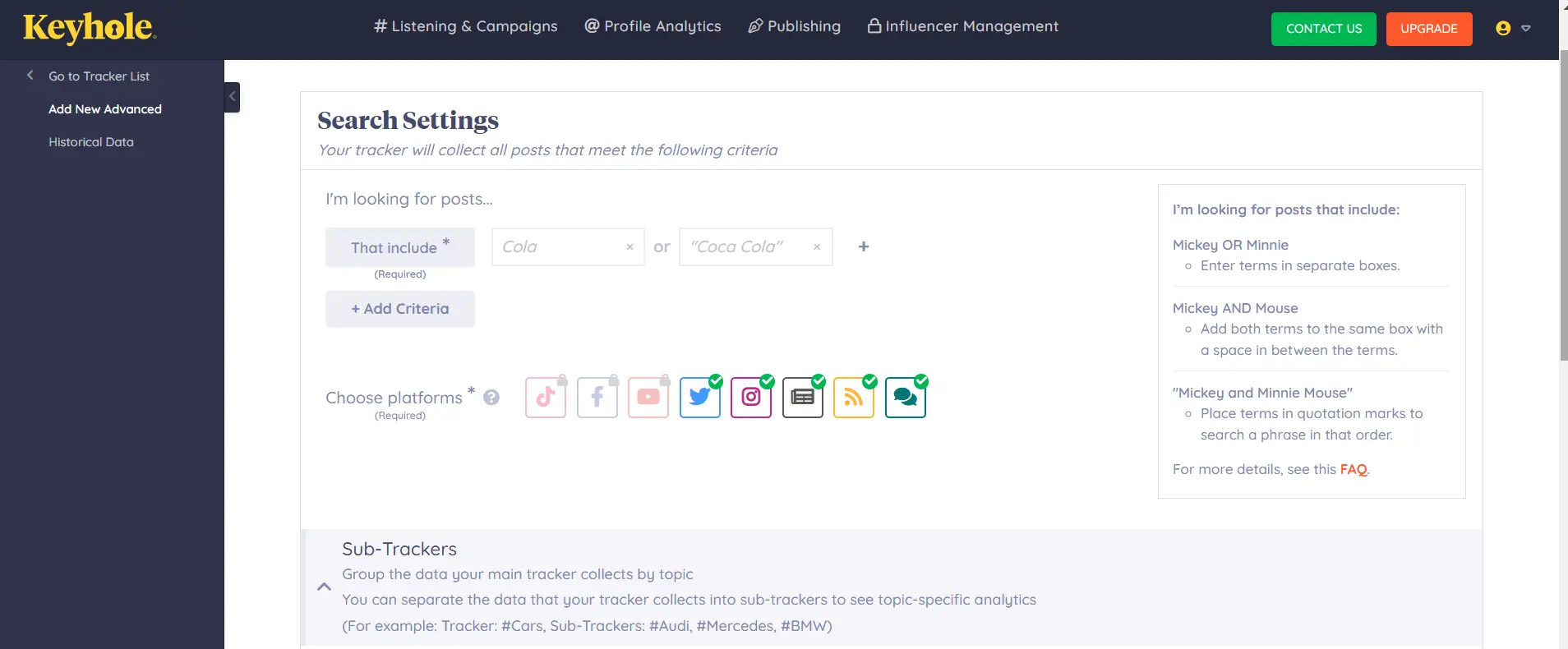
Source: Keyhole
Advanced Settings to Consider:
- Tracker name
- Required keywords (Additional keywords) - Each of which must be present for a mention to be collected (optional)
- Excluded keywords (Additional keywords) - None of which can be present for a mention to be collected
- Language
- Source
- Notifications and reports
Step 7: Working with Social Listening Data
After setting trackers, it's time to explore the social listening data. In the Mentions tab, you'll start to see results whenever someone mentions your chosen keywords on social media platforms.
Here's an example of a mentions stream:
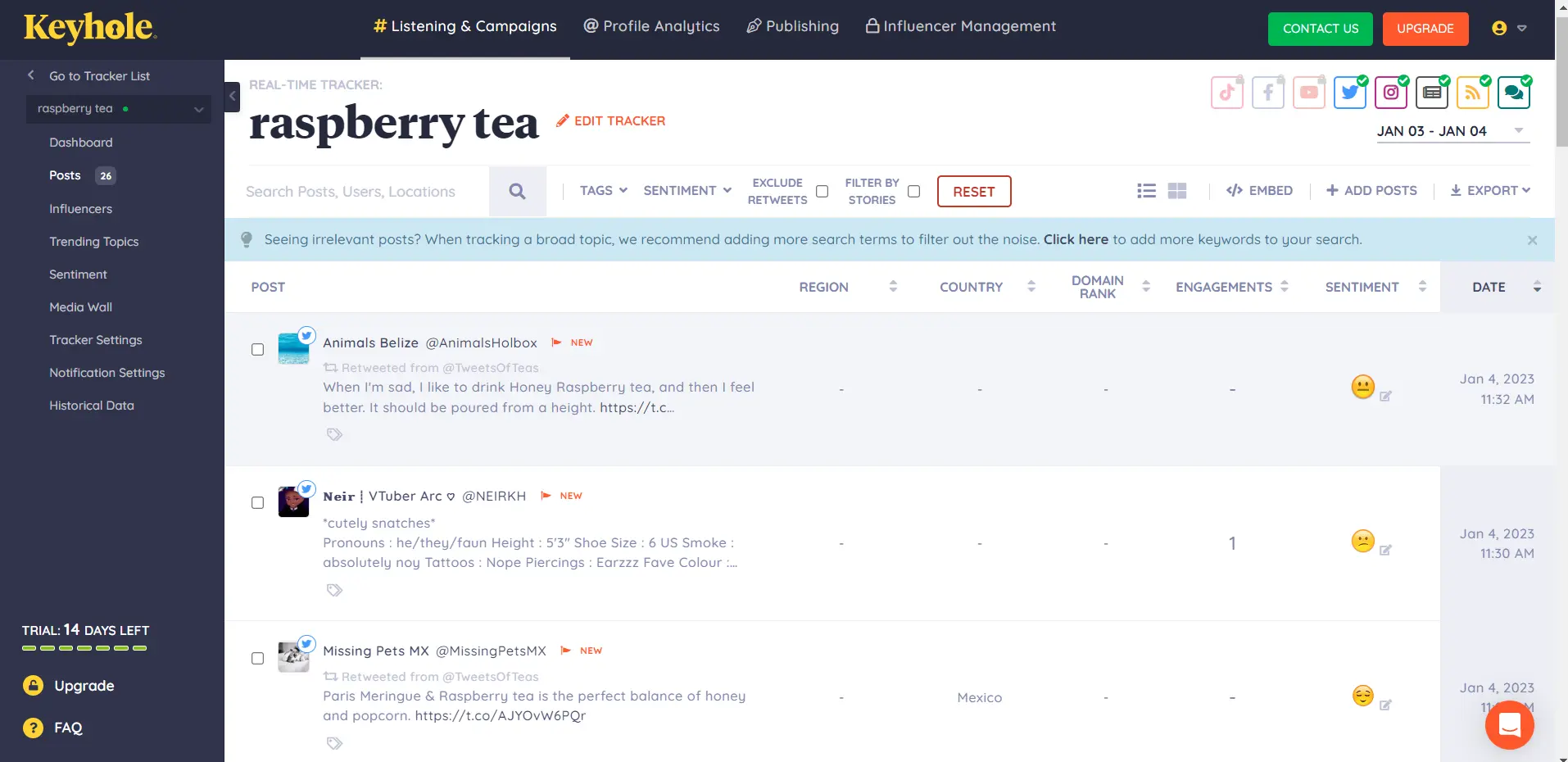
Source: Keyhole
From here, you can engage directly or take action based on the feedback received. It's best to monitor the results regularly and respond as necessary. You can click on mentions to be directed to the social media platform where you can respond, identify the sources that deliver the most mentions to focus on the most effective social media platforms, prioritize the most popular and important mentions, and check the sentiment of each mention to respond quickly to negative ones.
Step 8: Measuring Results Relating to Goals
After building topics, collecting data, and incorporating it into your strategy, you can assess your success by comparing your social listening data with social media analytics information. After listening, incorporating the data into your strategy, and running analytics, you should have a good sense of what works and what doesn't. Remember that a failed strategy isn't a failure or waste of time; taking risks and testing ideas is essential for growth.
Social listening tools that will do the research for you
Once you know what you wish to listen for, it's time to start using some social listening platforms. Here are the best social media listening tools you should be using.
Socialbakers
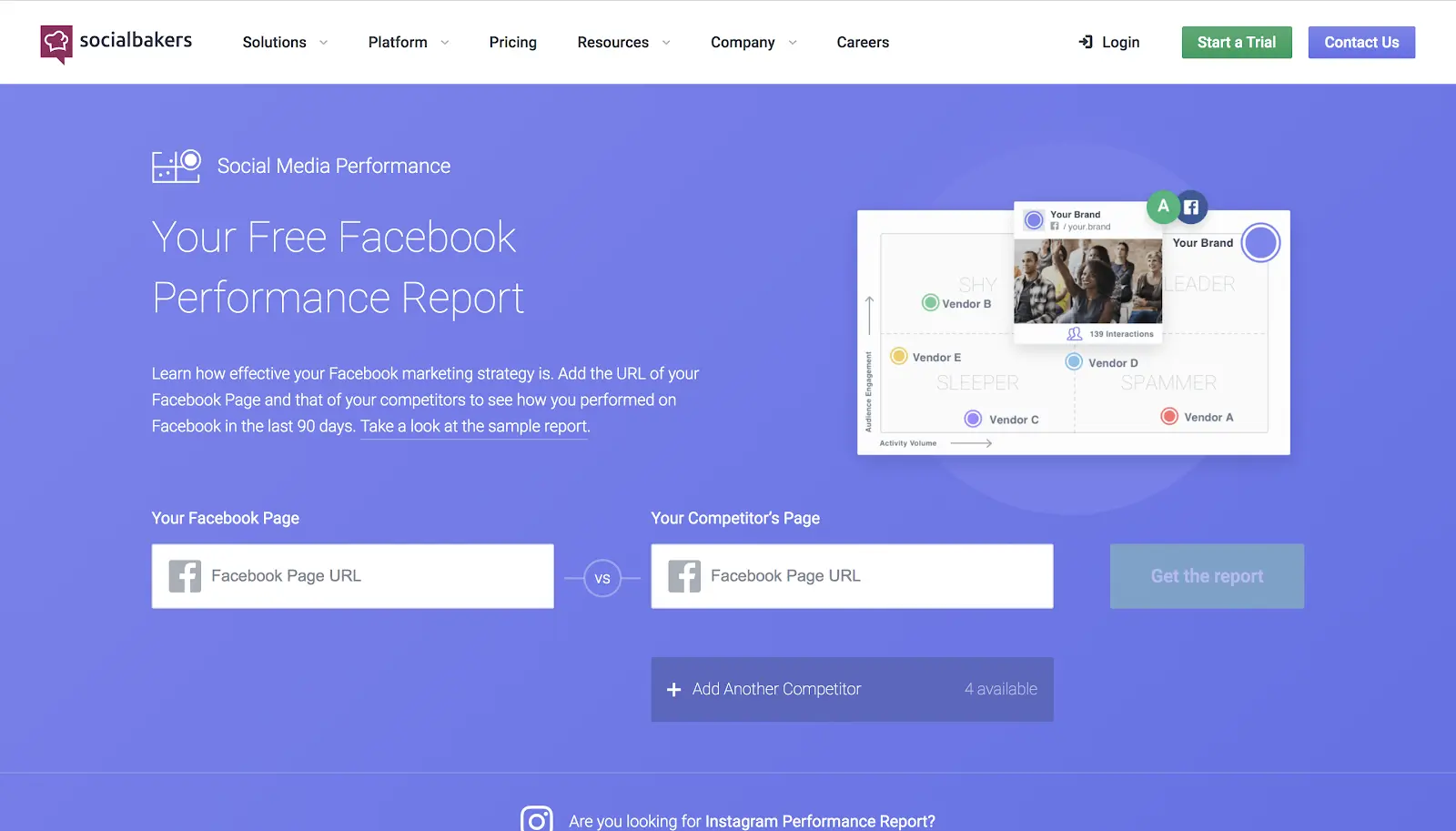
Socialbakers is a social media marketing platform that tracks over 8 million business profiles across the major platforms, including Facebook, Instagram, Twitter, LinkedIn, YouTube, Pinterest.
It provides vital insights into your audience, enabling you to manage your brand reputation by being aware of online conversations about your brand and engaging in them directly. With automated content and comment tagging, valuable data is made instantly accessible. A free trial is available, and the entry plan starts at £200 per month for 10 profiles or £400 per month for 20 profiles.
Mediatoolkit

Mediatoolkit is an award-winning media monitoring and social listening tool that helps users stay informed when their company, products, or services are mentioned online in any language across 100+ million sources. It tracks brand mentions and provides valuable audience insights to help businesses of all sizes build their strategy. Advanced data analytics are available to measure reach, sentiment, engagement, identify influencers, top locations and languages, and top-performing channels.
There are over 2000 customisable charts and dashboards to gain a competitive edge. Paid plans have unlimited users, keywords, and mentions, and there's a 7-day free trial to try it. Prices start at €99 per month with commitment, or €139 per month without.
Buffer
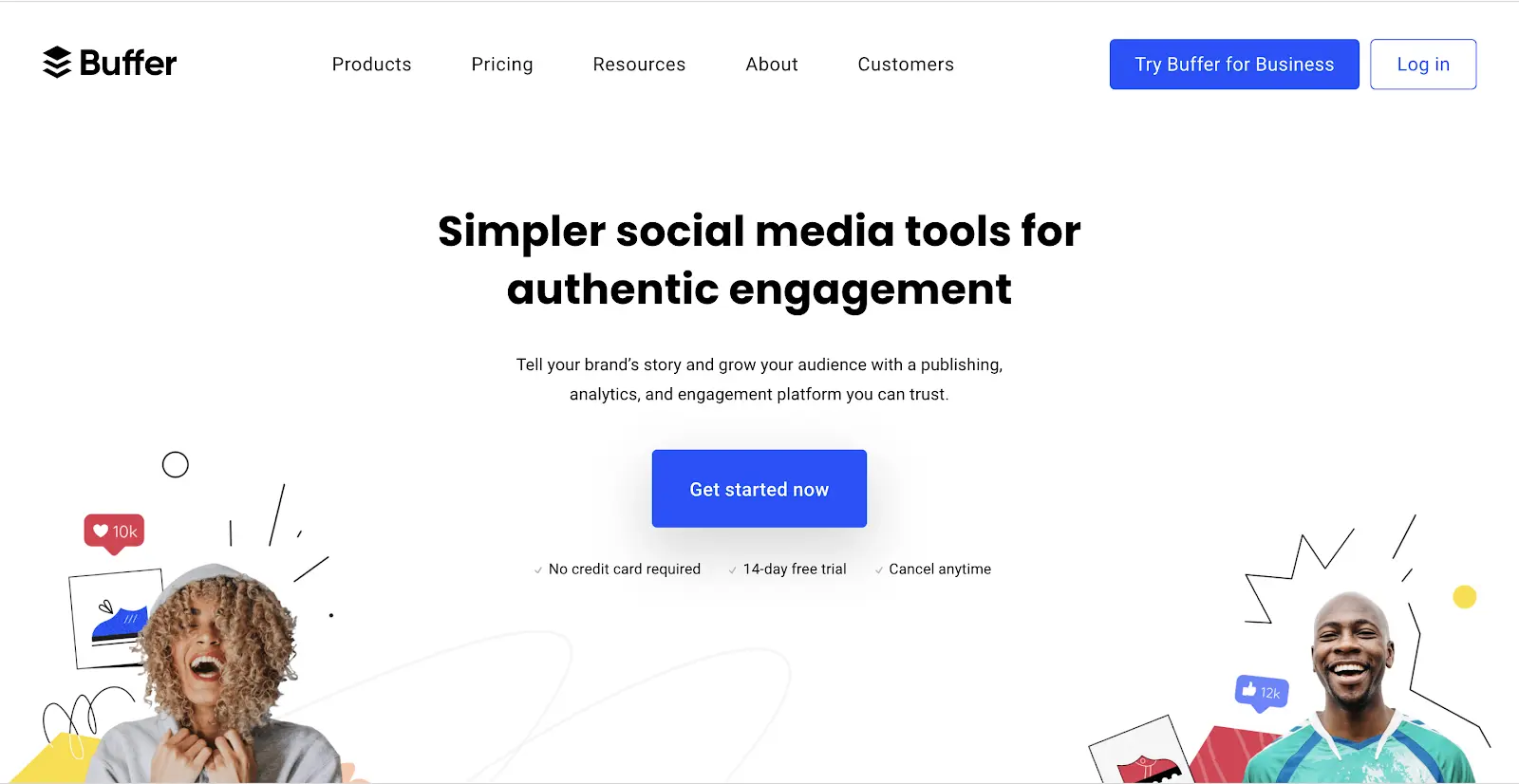
Buffer is a social media management platform that provides publishing, analytics, and engagement capabilities. It helps you plan and schedule your social media content and campaigns, analyse their success, and engage with your audience from one centralised dashboard.
With Buffer, you can improve your engagement on social media channels by visually planning your posts and campaigns. The platform also provides advanced analytics to measure the success of your efforts.
A 14-day free trial is available. Paid plans start from £15/month for publishing and £35/month for analytics, each including 8 social media accounts.
Synthesio
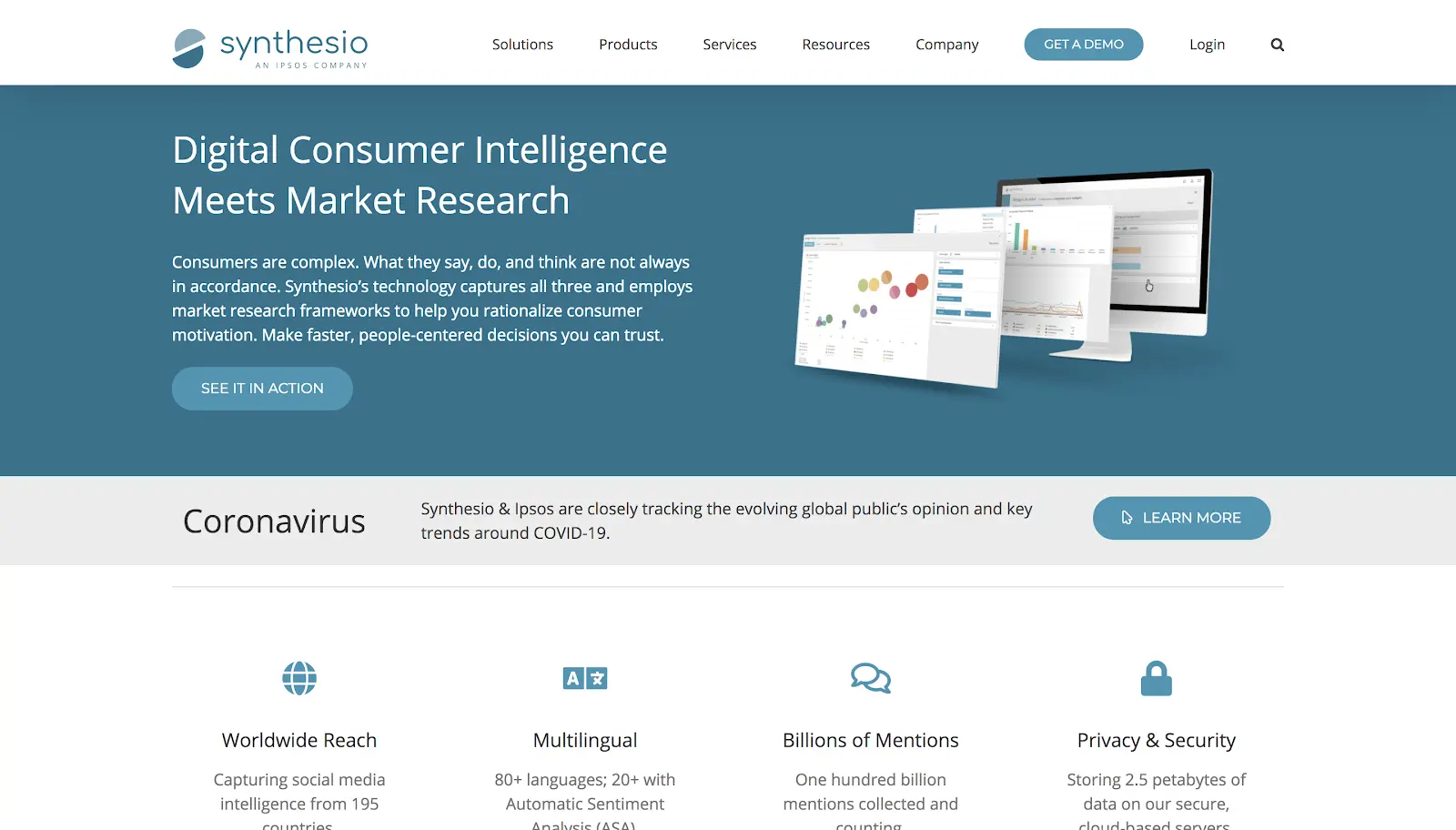
Synthesio is a social media monitoring tool that gathers data from 195 countries and 80+ languages. Brands can use it to gain insight into their audience and assess the impact of online conversations on their business goals.
The tool tracks likes, replies, views, favourites, retweets, and shares from Facebook, Twitter, Instagram, and YouTube on its dashboard.
No free trial or pricing information is currently available, but you can request a demo to see the platform in action.
Keyhole

Keyhole offers automated social media analytics for agencies, marketers, journalists and executives. It measures real-time and historical social media data and presents information in clear, easy-to-read graphs and layouts that simplify reporting and strategising.
Keyhole tracks hashtags, accounts, keywords, and URLs on Facebook, Twitter, YouTube, and Instagram, and can also be used for real-time campaign monitoring and optimisation, brand monitoring and optimisation, as well as data-driven market and competitor research.
You can try it during the free trial, while the paid plans start from $49/month for either social media and account analytics or social listening and campaign tracking.
Conclusion
In conclusion, social media can provide valuable insights into the changing preferences and behaviours of consumers. Ignoring these developments could result in a decline in brand standing compared to those that are more responsive. Customers prefer brands that are dynamic, interactive, and provide relevant and engaging products, services, support, and content.
To summarise, social media listening is the practice of monitoring and interpreting online conversations to gain insight and improve one's business. It enables the identification of key online mentions, which can then be promptly addressed. Consider the following when engaging in social listening:
- Manual social media listening can be tedious and less effective.
- Automated social listening tools can perform a large proportion of the work for you.
- Companies invest in social listening for sentiment analysis, raising brand awareness, keeping abreast of industry trends, comparing performance with competitors, and averting potential PR crises.
- Social media listening can help identify leads, but it is important to set up the project correctly and use filters intelligently.
- Setting goals and selecting keywords to monitor are crucial first steps in social listening.
- With the right tools, valuable metrics such as share of voice, presence and reputation score, social and non-social reach, AVE, EMV, etc. can be obtained.
- Many tools offer free trials, allowing for careful evaluation before committing to a purchase.
